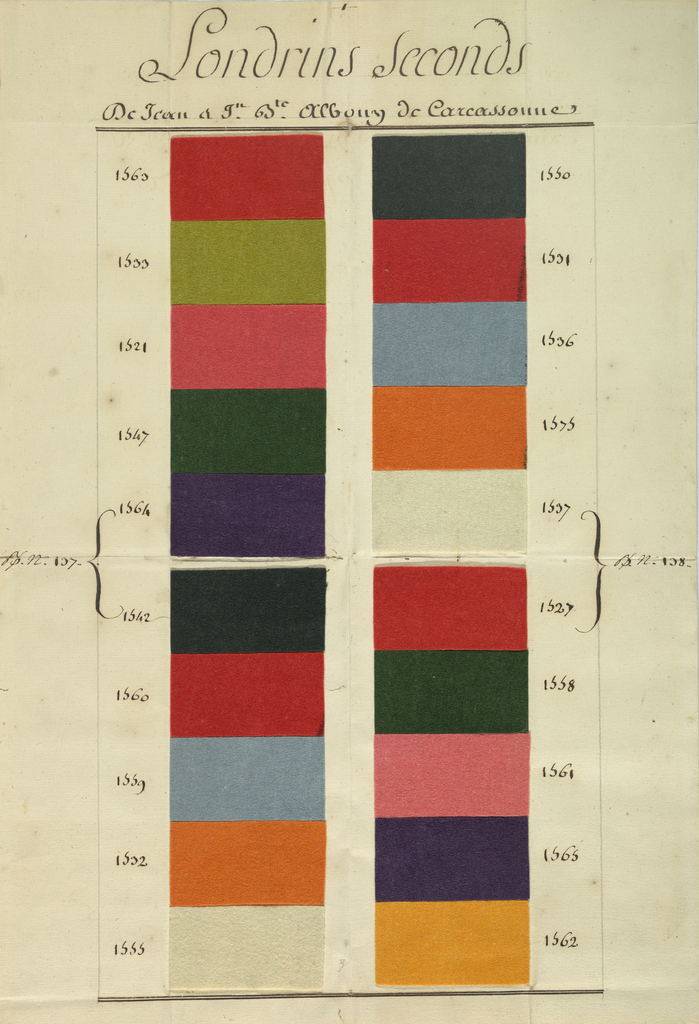Ancient Colors for Today’s Designers


Author: Dominique Cardon
September is New York Textile Month! In celebration, members of the Textile Society of America will author Object of the Day for the month. A non-profit professional organization of scholars, educators, and artists in the field of textiles, TSA provides an international forum for the exchange and dissemination of information about textiles worldwide.
It was bound for the Levant, Damascus, Aleppo. It is now in exile in New York, one of its kind, beautiful but meaningless unless contextualized. That is why I chose to tell its story.
This sample sheet is a montre, from the French verb montrer, to show. All along the 18th century, thousands of these travelled back and forth between the producers of fine wool broadcloth of the south of France (in this case, two brothers from Carcassonne) and their commercial agents and customers in the Levant, who bought upward of 100,000 pieces of such Londrins Seconds, measuring about 20 m in length per 1.40 m in width, each year. The montres worked as communication tools and powerful commercial weapons. Sent from the Levant, they showed the assortments of colours that were required in different parts of the Ottoman Empire: the elites of these countries of colour lovers expected the producers from the other side of the Mediterranean to follow the fluctuations of the tastes and fashions of their different social circles with the utmost reactivity: « above all, the assortments for the bales must be strictly observed concerning the colours, which change here nearly twice a year; one must take care to send new ones every six months» advises the author of a memoir written in the Levant around 1680 CE. Sent from Languedoc with each bale of cloth, the samples on the sheet served as reference standards of conformity and quality, without having to unpack. The beauty of their colours and quality of their dyes eventually won the markets of the Ottoman Empire over the English cloths from which the Londrins Seconds were inspired and took their name.
Today, these documents can be used again as wonderful tools by the growing numbers among the young generation of colourists, designers and dyers with a keen interest in the colours of the past, thanks to my recent publications of dyers’ books illustrated with samples, giving detailed recipes on how to obtain all the beautiful colours on the montres. The name of each shade, not mentioned here in front of the samples, figures in the dye books and on many other montres. Colorimetric measurements of hundreds of such samples have allowed me to collect their colorimetric characteristics in the CIE Lab* system: objective and precise correlations can now be established between them, the colour name corresponding to each shade, identified, and the shade reproduced exactly, with the same ingredients as in the recipes or with any suitable colorants, natural of synthetic, since the results can be matched with the colorimetric definitions of the samples. Some designers may want to revive these ancient colours as a natural and essential part of the new conception and production process emerging with the “Slow Fashion” movement. Others may simply use them as an inspiration for new colour trends.
Imagine… Colours of the past, escaping from these pattern sheets and the pages of old dye books. Persian blue, raven, dainty blue, pomegranate flower, spiny lobster, winesoup, pale flesh, dove breast, golden wax, grass green, green sand, rotten olive, modest plum, agate, rich French gray, gunpowder of the English, finding their way to the streets of our cities, enlivening everything we wear, all allied to dissipate the bleakness of the times.
“You may say I’m a dreamer…” Historians do like to think that understanding the past can inspire the future.
Dr. Dominique Cardon, Senior Researcher at French CNRS. (National Centre of Scientific Research), is the author of books, and organizer of international symposiums and exhibitions on Natural Dyes. She was made Chevalier de la Légion d’Honneur in France and Chevalier de l’Ordre des Arts, des Lettres et de la Culture of Madagascar for her contributions to textile research.
Suggested further reading:
Cardon, D. (2016)The Dyer’s Handbook – Memoirs of an 18th century Master Colourist. Oxford and Philadelphia: Oxbow Books.
One thought on “Ancient Colors for Today’s Designers”
Kate on October 4, 2017 at 9:13 am
Wow. Fast fashion even back then